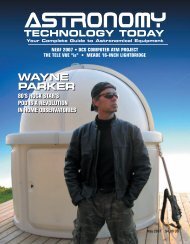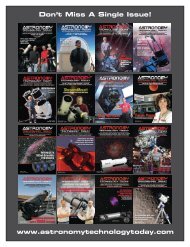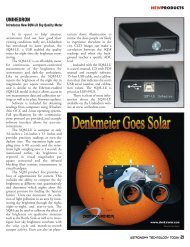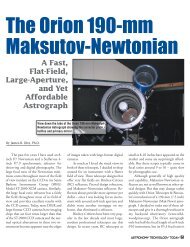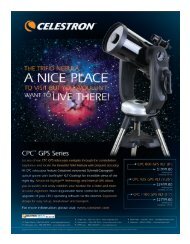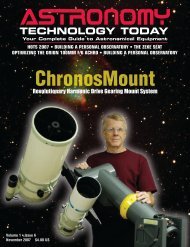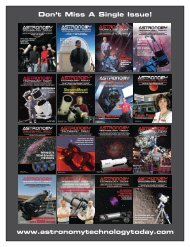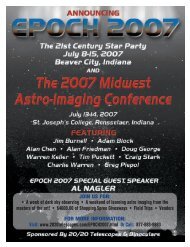iOPTRON - Astronomy Technology Today
iOPTRON - Astronomy Technology Today
iOPTRON - Astronomy Technology Today
You also want an ePaper? Increase the reach of your titles
YUMPU automatically turns print PDFs into web optimized ePapers that Google loves.
THE RIGEL SYSTEMS USB NSTEP AND ASTROSYSTEMS COLLIMATION TOOLS<br />
The AstroSystems LightPipeSight-<br />
Tube Combination tool features a unique<br />
“non-directional” illumination cap. If<br />
you’ve used a classic Cheshire, you know<br />
how frustrating it can be to try and keep<br />
your flashlight in perfect alignment with<br />
the narrow illumination port with one<br />
hand while trying to make fine adjustments<br />
to collimation screws with the<br />
other. The AstroSystems illumination cap<br />
captures light from any angle, making it<br />
far easier and more enjoyable to use.<br />
After using the LightPipe/Sight-Tube,<br />
my collimation was better, but still not<br />
perfect! I moved on to the Autocollimator,<br />
which AstroSystems describes as “taking<br />
some practice” to use perfectly. Practice<br />
indeed! What first appeared difficult soon<br />
became second nature. At first glance, you<br />
install the tool and see multiple reflections<br />
of the center spot. It was so sensitive to<br />
alignment, that simply touching one of the<br />
focuser set screws caused several of the<br />
reflections to jump. No doubt this thing<br />
would show me any remaining issues! In<br />
simplest terms, the goal of the autocollimator<br />
is to get the reflections to converge.<br />
If you are close with the LightPipe, it won’t<br />
take more than a few small tweaks to get<br />
everything right. Once that’s the case, collimation<br />
is spot on.<br />
The cool thing about these tools is<br />
that they can be used in broad daylight.<br />
No need for a clear, steady night and a star<br />
test. No worry that some miniscule detail<br />
in mirror positions will keep you from<br />
excellent details in your observing or imaging.<br />
No, with proper use of this LightPipe<br />
and autocollimator, you can bet your<br />
optics will be well aligned.<br />
Rigel Systems USB nSTEP<br />
Pinpoint stars, here I come. Or so I<br />
thought. I was able to get much better<br />
images than ever before, but they still<br />
lacked the detail and sharpness of what I<br />
expected. Compared to images from similar<br />
setups, my results still looked soft.<br />
What was I missing? I’d corrected coma<br />
and tackled collimation, so why didn’t I<br />
Image 2 - The AstroSystems Autocollimator is also available in 1.25-inch and 2-inch configurations.<br />
Both are precision aligned to within 3 arc minutes.<br />
have nice stars? To answer my own question,<br />
I simply needed to focus.<br />
It’s not a secret that good focus is<br />
required to get sharp images. What is perhaps<br />
overlooked is just how small the<br />
range of good focus can be for some<br />
scopes. Small for all scopes, this range of<br />
focus gets smaller as the f-ratio gets shorter.<br />
This means that focus becomes more<br />
critical with faster optics. A few hun-<br />
<br />
<strong>Astronomy</strong> TECHNOLOGY TODAY 63



